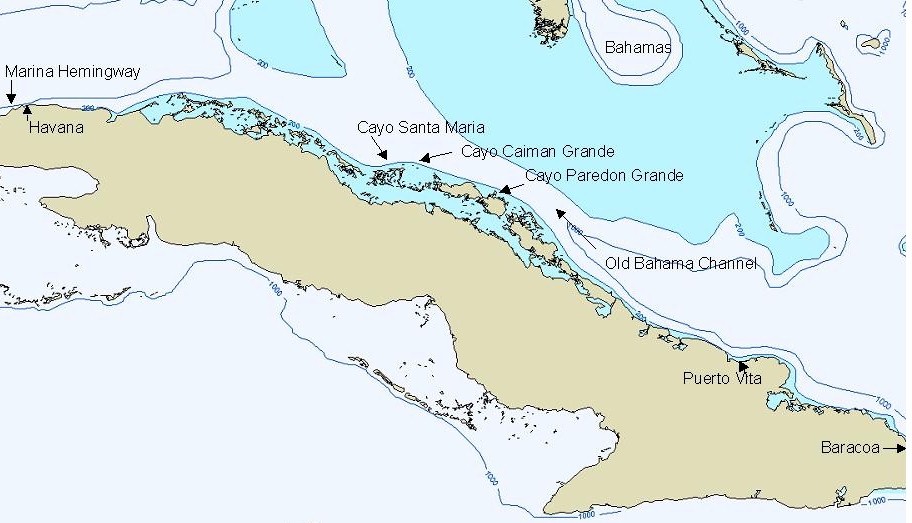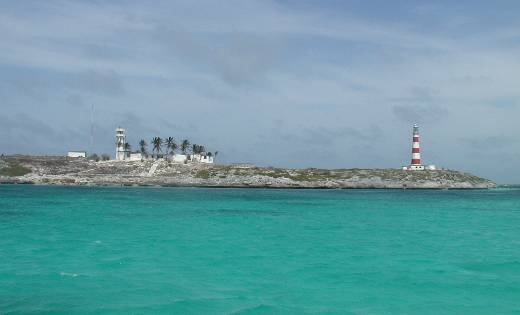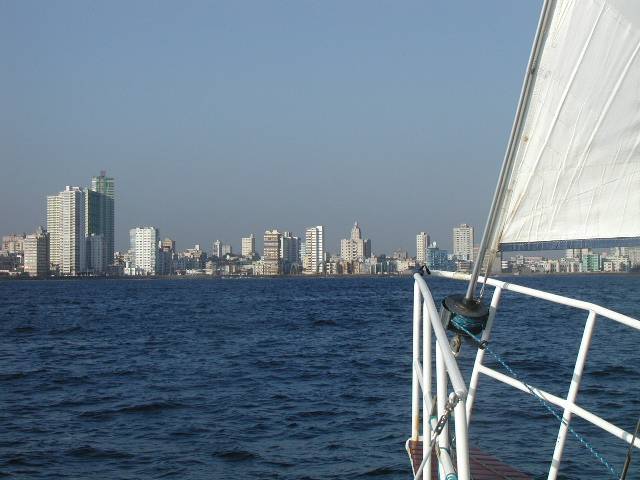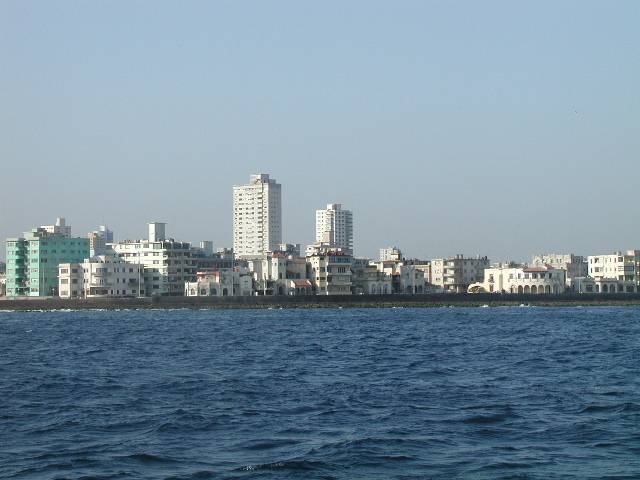Puerto Vita to Havana via the Northern Cays
18 - 26th April 2004

Expensive anchorage at Puerto Vita and scene of the long-awaited success in the hunting of the snook!

We spent another few days in Puerto Vita, waiting for the wind to drop enough to continue our voyage further west. We kept ourselves busy with Scrabble and devising new recipes for Snook! Finally we were able to leave early in the morning for an overnighter to Cuba's northern cays. The wind was still quite strong and the sea pretty uncomfortable.
Around 2 pm we hooked a large dorado, which thrashed around on deck, whilst we just hung on to the boat and tried not to slide around in its slippery trail. The icebox in the fridge was already full of snook and now we had to find a way to store fillets from a even bigger dolphin fish too!
As we approached the Old Bahama shipping channel, we started to see a lot of ships heading the opposite way to us, but we stayed well inside the shipping separation zone to avoid them. Around 6 am we were called up by Coastguard station at Cayo Confites, who wanted all the details about who we were, our boat, where we were going and where we'd been - all tricky in Spanish after a sleepless night!

A slippery customer - Dolphin Fish

Who said it was a sleepless night?

Mario and his lighthouse
We were given a very interesting tour by Mario, who has been the lighthouse keeper on Paredon Grande since 1991 and has worked in lighthouses for 34 years, 15 days on 15 days off. He proudly walked us to the top of the lighthouse, opening the shutters on the way for us to get a good look at the view. He showed us how he winds the counterweight up to the top of the lighthouse, which has to be done three times a night, to keep the light rotating. Apparently the light bulb is 2000 Watts, so it gets pretty warm up there!
Christine was taken outside on the walkway at the top of the lighthouse but didn't climb the open ladder to an unguarded platform around the windows though! The lighthouse was made of steel and the mechanism was French. Luckily Mario didn't have to paint it himself though, a crew comes every two years to keep the yellow and black checkerboard finish up to scratch. The crew on the island also use the outside of the lighthouse to collect rainwater, it runs down the side of the lighthouse into a gutter and then is collected in a large tank at the base of the lighthouse. At the time of our visit the tank was empty, so we don't know how they manage for water. Just to be sure they don't die of thirst, we went ashore illegally again to take some Coco Cola and beer for Mario, to thank him for the interesting tour. The island is famous for its mosquitoes, so that and the cold wind kept our portholes shut that night!

"Wow, we're a long way up - come and check out the view!"

"But I don't like heights!"

We didn't attempt to land on Caiman Grande as it was steep rock down to the shore. We weren't sure how the staff got ashore. It too had its brightly coloured lighthouse in red and black, but not as impressive and tall as the one we'd visited.

Cayo Caiman Grande decorated with the "men in green's" laundry!
Next day we headed for Cayo Santa Maria, as the pilot book said there was nice coral there for snorkelling. On the way we passed more massive all-inclusive resorts and also several Hobie Cats packed with tourists which crossed our path. The anchorage we'd chosen was shallow quite far out from the shore, so we ended up anchored a long way from anywhere. The island didn't seem to be anything special, so once we'd had a snorkelling trip in the eternally howling wind and enjoyed a spot of beach-combing when we found our first sand dollars on the beach, we decided we'd set off that night to Havana, a 36 hour trip. The weather forecast was for another cold front in a couple of days and we didn't want to end up stuck in Varedero, another tourist centre.
It was quite rough on the way out to the deep water and uncomfortable, as we were beam on to the waves, but things improved a bit later. We had reefs in the genoa and the main, partly due to the wind strength but also so we wouldn't go too fast and arrive in Havana during the following night. The night was pretty rolly and uncomfortable and it was hard to rest.
We spent most of the next day at sea trying to slow Anju down, so we wouldn't arrive in Havana too soon. Most of the afternoon, when the winds were up to 30 knots, we travelled with only a double reefed main and still struggled to keep our speed down. Luckily we had current against us for a while, as the boat speed was still over 6 knots. At around 11 pm we had to gybe, including swapping the genoa pole over to the port side of the boat, which was quite tricky in the dark and with the waves still quite big, but after about an hour it was finished.

Anju approaches Havana's famous seafront Malecon.

By the time it was light we were approaching the city of Havana and sailed quite close in to the shore to get a good look. At around 9 am as we were motoring along beside the city, both our GPSs suddenly failed for quite a while but we realised if it was both of them at once, the problem must be external. We wondered if the signal was being jammed as we passed Havana, or perhaps we were just getting paranoid! Anyway a few minutes later everything returned to normal. We wove our way between a fleet small boats of local fisherman but didn't see anyone fishing from truck tyres on that occasion as we did on a later visit.
By 10.30 we'd found our way through the frightening channel lined with reefs, which leads into Marina Hemingway and tied up on the Customs dock. This was also quite scary, as below the waterline, a large ledge stuck out from the dock, so we had to use all the fat fenders we could find to hold Anju off. Soon we had the usual crowd of officials on board, including this time a sniffer dog, which would be lucky to smell anything beyond its own smell. The man and woman in green were next aboard and seemed to keep filling the forms in wrong and having to go to fetch another one. They "searched" the boat again but gave up when they saw all the junk in the forepeak!
Next aboard was the large and friendly immigration man, who even radioed to the marina for us, to get a berth number. Nobody asked us for "donations" but later we met people who checked in to Cuba in Havana and it cost them plenty to keep everybody happy - perhaps Puerto Vita was a good choice as a port of entry!
We were glad to have arrived in Havana but a little disappointed that we couldn't spend more time in the quieter anchorages of the north coast. Despite planning our visit for the time of year which our pilot book advised was the best (maybe the only) time of year to visit that coast, with predominantly south-easterly winds, every afternoon we found ourselves enduring strong winds of 25 to 30 knots from the north east, due to the land effect of the Cuban mainland combined with a strong high pressure in the Atlantic. Of the limited number of anchorages on the north coast that our draft would permit, many were untenable and those we could visit were uncomfortable in the strong winds and swell. On our next visit we'll travel along the south coast instead.